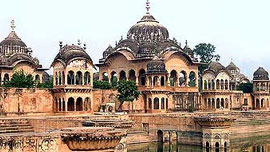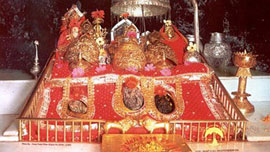
Mata Vaishno-Devi, Katra
Mata Vaishno Devi Shrine is located near the Katra district at a height of 5200 ft. The Devi resides inside a cave on Trikuta, a three-peaked mountain. After reaching Katra, one has to undertake a trek of approximately 12 km to reach the cave of Mata Vaishno Devi. After the trek is over, the yatris (devotees) are blessed with the darshan (a view) of the goddess inside her holy cave. The cave does not contain any statues or photos. The cave houses three natural rock formations, called the Pindies that represent the three goddesses. The pindi in the middle represents Laxmi Mata, on the right is Kali Mata and on the left is Saraswati Mata. Vaishnodevi pilgrimage tour is considered to be one of the holiest pilgrimages in India.
There are numerous legends associated with the Mata. It is believed that the Goddess is a combination of Tejas or spiritual strength of her three main manifestations, Mata Kali, Mata Lakshmi and Mata Saraswati. From the union of the Tejas of the three Goddesses emerged a beautiful girl. She was created to live on earth and uphold virtue and morality. Later, she took birth in the house of a Ratnakar in the southern part of India and named Vaishnavi. But, she was not supposed to be a common human being. She renounced the world and went to forests to meditate and lead an austere life.
Amarnath, Kashmir
Amarnath Cave is located in a narrow gorge on the farther end of Lidder valley at 3,888 m above sea level. The cave is 45 km from Pahalgam and 141 km from Srinagar. The trek begins in July-August. Despite being an extremely difficult trek, millions of devotees come to pay homage to Shiva in one of his Himalayan abodes. The yatra, in its present religious form, commences with the ceremony of "Chari Mubarak," at the Dashnami temple, Akhara, Srinagar.
After the prayers, the yatri acquires a sort of walking stick. It has both physical and religious significance: physically, it helps the yatri in steadying himself on a snow covered slippery path; spiritually it reminds him of his resolve at the temple at times when his faith begins to waver in the face of a long and arduous journey. Nowadays people travel to Pahalgam first and then undertake the onward journey of 45 km on foot, in batches. Overnight halts are in encampments that are set up at fixed distances and give the appearance of a military site. The return trek has to be covered in five days with night halts at Chandanwari, Wawjan and Panchtarni.

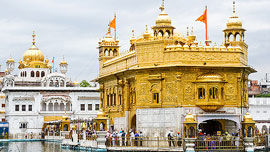
Golden Temple , Amritsar, Punjab
The foundation of the Darbar Sahib had been laid by Guru Arjan Sahib on January 3, 1588. In 1590, Guru Arjan Sahib moved to village Wadali where Guru Hargobind Sahib was born on June 19, 1590. By 1601, the Darbar Sahib was fully ready. In 1603-04, the first volume of Guru Granth Sahib, the Sikh scriptures, was prepared in this city and was installed at Darbar Sahib on August 16, 1604.
The temple's architecture draws on both Hindu and Moslem artistic styles yet represents a unique coevolution of the two. During the reign of Maharaja Ranjit Singh (1780-1839), Hari Mandir was richly ornamented with marble sculptures, golden gilding, and large quantities of precious stones. Within the sanctuary, on a jewel-studded platform, lies the Adi Grantha, the sacred scripture of the Sikhs. This scripture is a collection of devotional poems, prayers, and hymns composed by the ten Sikh gurus and various Moslem and Hindu saints. Beginning early in the morning and lasting until long past sunset, these hymns are chanted to the exquisite accompaniment of flutes, drums, and stringed instruments.
Bodh Gaya, Bihar
Bodhgaya is one of the most important and sacred Buddhist pilgrimage center in the world. It was here under a banyan tree, the Bodhi Tree, Gautama attained supreme knowledge to become Buddha,the Enlightened One. Born; in the foothills of the Himalayas as a Sakya prince of Kapilvastu (now in Nepal), most of the major events of his life, like enlightenment and last sermon, happened in Bihar. Buddhism as a religion was really born in Bihar and evolved here through his preaching and the example of his lifestyle of great simplicity, renunciation and empathy for everything living.
Significantly, the state's name of 'Bihar' originated from 'Vihara' meaning monasteries which abounded in Bihar. Several centuries after Buddha's passing away, the Maurya Emperor Ashoka (234-198 BC) contributed tremendously towards the revival, consolidation and spread of the original religion. It is the monasteries, Ashoka built for the Buddhist monks and the pillars known as Ashokan Pillars erected to commemorate innumerable historical sites associated with the Buddha's life, mostly intact to this day, that helped scholars and pilgrims alike to trace the life events and preaching of a truly extraordinary man.
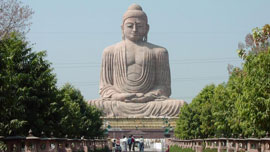
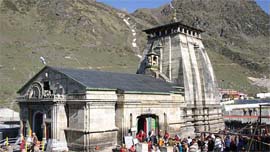
Kedarnath, Uttar Kashi, Uttranchal
Kedarnath is amongst the holiest pilgrimage for the devout Hindu, located in the Uttaranchal state of India. Kedarnath, where a form of the Lord Shiva is venerated as one of the twelve jyotirling (linga of light), is one of the four sites in India's pilgrimage Char Dham. The most remote of the four Char Dham sites, Kedarnath is located in the Himalayas, about 3584m above sea level near the head of river Mandakini, and is flanked by breathtaking snow-capped peaks.
Besides its affiliation with Shiva, Kedarnath is also believed to be the site of Shankaracharya's samadhi (achievement of beatified afterlife). The actual temple is an impressive stone edifice of unknown date. No specific family of pujaris supervises rituals at Kedarnath, which focus around veneration of the stone lingam that rests in the inner sanctum of the temple.
Tirupati, Andhra Pradesh
Tirupati is the name which requires no introduction. Known for embracing the world's richest temple, Tirupathi is a revered temple town, situated in the Chittoor district of Andhra Pradesh. The city earns a considerable fraction of tourism prospects of only not the state, but the whole of India. Tirupati Temple, being the highly revered pilgrimage site of the Hindus, gets major attention of devotees all over the world. It's a place where all wishes and requests of people come true.
The term 'Tirupati' is made of two words, where 'Tiru' means 'Sri' and 'Pati' means 'Husband'. Thus, 'Tirupati' suggests 'Maha Vishnu' or 'Lord of Maha Lakshmi'. Dotted with several temples and immersed in the divine aura in conjunction with scenic beauty, Tirupathi appears truly charismatic. Apart from Sri Venkateswara Temple, there are many famous shrines here, like those of Govindaraja, Rama, Mallikarjuna, etc. In the earlier times, the town was ruled by the rulers of various dynasties of South India. Though Tirupati Temple is very old, huge contributions were made by many Kings for its development. The temple town represents the rich cultural legacy of the past. The Tirumala Hills with its lofty peaks, further add to the glistening charm of the town. Travel to Tirupathi and see the spiritual grandeur of the city yourself.
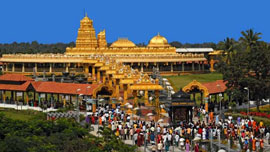
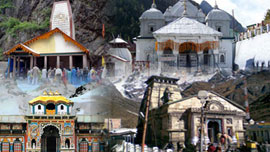
Chardham Yatra
The Char Dham, also called the Deo Bhumi - The Adobe of the Gods - presents just the ambience where the Divine & the Sublime coexist. Once there, the sheer magnificence and the tranquil beauty so immerses you into a world of spirituality that you experience true peace and humility. Nature in all its splendour, at once huge and overwhelming and yet humble in its exquisite beauty - the pilgrimage to the Char Dhams is the experience that will stay with you and beyond.
Uttaranchal abounds in places of sanctity where devotees converge every year to pay obeisance to their Gods braving vagaries of weather & other human travails in Himalaya. Closest to the celestial beings, devotees from all corners of the country have flocked to these Himalayan shrines of Char Dham - Yamunotri, Gangotri, Kedarnath & Badrinath every year to seek salvation. The arduous trails remain in the ancient sanctuaries of faith for a fulfilling experience. The four dhams receive holy water in the form of four streams - Yamuna (Yamunotri), Bhagirathi (in Gangotri), Mandakini (in Kedarnath) and Alaknanda (in Badrinath).
Vrindavan, Uttar Pradesh
Vrindavan, around 15 km from Mathura, is a major place of pilgrimage, on the banks of Yamuna . Attracting about 5 lakhs pilgrims every year, it is noted for its numerous temples- both old and modern. Vrindavan is synonymous with the innocent mirth and child like playfulness of Shri Krishna. Vrindavan, the dusty little town known for the temples, big and small, famous and remote strewn all over the place.
The name 'Vrindavan' is derived from 'Vrinda', another name for the sacred tulsi (basil) plant. A legend has it that the entire place was a tulsi grove at one time. According to another tradition, it was named after Vrinda Devi, one of Krishna's playmates. The earliest known shrine in Vrindavan is said to have been built by the local gosains in a large garden called Nidhiban, later named Seva Kunj. According to tradition, Emperor Akbar was taken blindfolded inside the grove where he had some kind of a spiritual experience. As a result, he acknowledged the spot as being holy ground.
